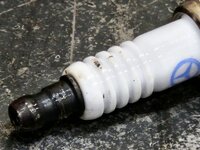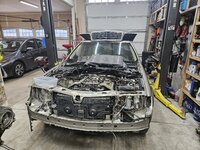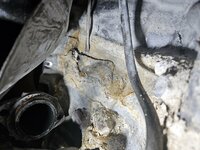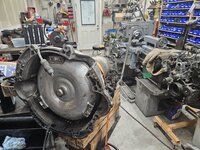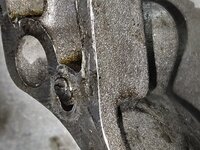I think my hot idle misfire may be fixed.
It had gone away after I went through the whole system and replaced everything, including the spark plugs. It ran fine for a couple weeks after that, although to be fair I drove it very little during those couple weeks.
I pulled the caps off over the weekend and discovered oil in the bottom of the right side cap. I previously had thought this was from a leaking valve cover gasket, but when I was in there a few weeks ago I cleaned up all the oil residue, so this time I was able to see that the leak was actually from the cam solenoid. The left side solenoid was also seeping just a bit.
My 95 5.0 is sitting on a stand next to the car with its solenoids sitting right out in the open, so I decided to reseal those and install them. I'm pretty sure I remember reading somewhere that the later solenoids are preferable to the earlier ones. I followed JC220's repair how-to. I had the stainless rivets on the shelf already since I was planning on doing this at some point.
100x 1/8" M3.2 Stainless Steel Closed End Countersunk Blind Rivets ISO 15973 | eBay
These are the rivets I used. I knew I wouldn't be using them for a while, so I just ordered a bag of 100 from China. They arrived in about 2 weeks.
I definitely recommend using a drill press (or vertical mill) to drill the old rivets if you have one. Countersinking the holes deep enough to ensure the entire head of the rivet will sit flush or lower is absolutely required to ensure the solenoid will seal to the cylinder head.
The drill press will make that much easier. Rather than using a traditional countersink bit, I used a 90 degree carbide rotary burr. The carbide stays sharp and allows for smooth, controlled removal of material.
 SK-5 90° Countersink Premium Tungsten Carbide Burr
SK-5 90° Countersink Premium Tungsten Carbide Burr
No affiliation. This is the exact tool I used.
The original how-to showed using the original seals with silicone RTV on either side. I didn't see any reason to keep those seals. I removed them and just used one fat bead below the magnet, and another above.
I clamped it together and popped the rivets in. I then made sure to clean all excess silicone from the solenoid, including inside the magnet bore. Once it was all clean, I let it set for two days.
While that was curing, I pulled the distributor insulators from my 5.0 and cleaned them up. They are OE MB, and looked to be in good condition. I cleaned them up, and then I decided to coat them inside and out with 4 or 5 coats of clear coat.
Yesterday I installed the solenoids using anaerobic sealer. Today I installed a new power steering filter, since the reservoir had to come off to remove the left side solenoid, and then I reassembled everything. I swapped the Bosch rotors back in since they were in good shape and I trust them more than the Bremi rotors I had in there from last month's work.
Took it out for a lengthy test drive, and the car ran flawlessly. Only time will tell, but I assume the oil shmoo was the issue. Like any good scientist, I changed several variables, including the insulators and rotors, so I guess I can't say for certain that it was the oil, but that certainly seems like the most likely cause.









